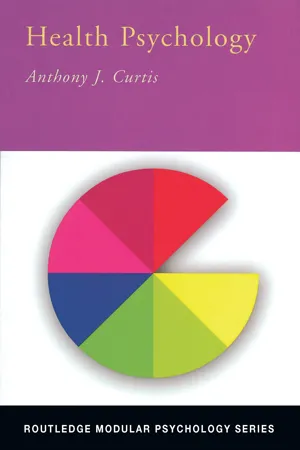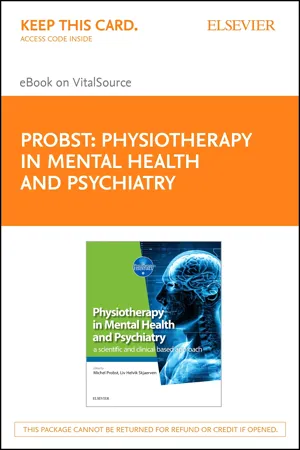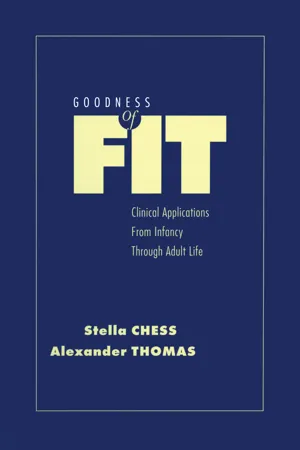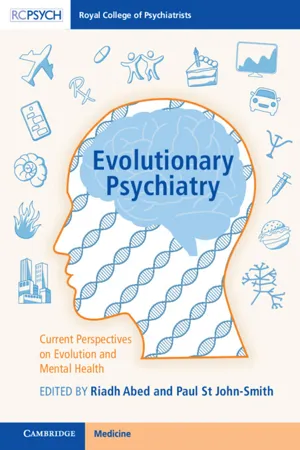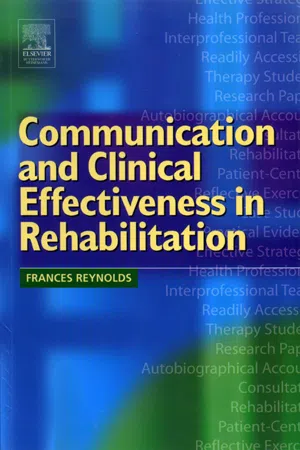Psychology
Biopsychosocial Model Psychology
The biopsychosocial model in psychology considers the interplay of biological, psychological, and social factors in understanding human health and behavior. It emphasizes that physical health, mental health, and social well-being are influenced by a combination of biological, psychological, and social factors. This holistic approach recognizes the complex and interconnected nature of human experiences and health outcomes.
Written by Perlego with AI-assistance
Related key terms
1 of 5
12 Key excerpts on "Biopsychosocial Model Psychology"
- eBook - PDF
Health Psychology
A Critical Introduction
- Antonia C. Lyons, Kerry Chamberlain(Authors)
- 2006(Publication Date)
- Cambridge University Press(Publisher)
For example, well-being might require the elimination of poverty and freedom, enabling people to live in a society with social justice. However, under this definition it is difficult for very many people to be cate-gorised as healthy. Furthermore, it has been criticised because it is idealistic and utopian (Seedhouse, 1986 ). In summary, disenchantment with the biomed-ical model, and an increasing focus on social and psychological influences on health, led to the development of the biopsychosocial model (Engel, 1977 ). The biopsychosocial model Essentially the biopsychosocial model states that health and ill-ness arise from the interplay of biological, psychological and social factors (Engel, 1977 ). For example, biological factors such as genetic predisposition, behavioural factors such as smoking and stress and social conditions such as social support and peer relationships may all contribute to the development of a particular disease (such as cancer). In terms of the mind–body debate, the biopsychosocial model has a holistic approach and sees that the mind and body are both involved in health and illness. Initially proposed by psychiatrist George Engel ( 1977 ), this model developed out of a need for medicine to take the patient into account, including her social context and how society deals 12 Health Psychology with her illness. The biopsychosocial model is certainly in accord with the definition of health provided by WHO in 1948. While the biopsychosocial model has been a major influence in the devel-opment of health psychology (Marks et al ., 2000 ) it has received consid-erable criticism. Researchers have argued that the biopsychosocial model is still essentially biomedical and needs further theoretical work (e.g. Armstrong, 1987 ; Ogden, 1997 ). In psychiatry McLaren ( 1998 ) has strongly argued that the biopsychosocial model is seriously flawed and should be abandoned. - eBook - ePub
- Anthony Curtis(Author)
- 2002(Publication Date)
- Routledge(Publisher)
cognitive-behaviour therapy in treating a whole range of disorders. Although the mechanisms linking mind and body are not well understood, many health professionals now believe there is a link and that the absence of evidence should not be taken as evidence of absence. The Biopsychosocial ModelDuring the last quarter of the twentieth century, physicians, psychologists and medical sociologists have seriously questioned the usefulness of the medical model in explaining health and illness. The biopsychosocial model (see Figure 1.1 ) is based on a systems approach. At one end of this scale, as Banyard (1996) states, we exist within an ecological system that includes the planet we live on, the life we have developed from and the species we are part of. At the other end of the scale, we are made up of the basic units of the universe (molecules, atoms, etc.). There are no single causes in explaining phenomena here. Instead, many factors influence each other on different levels.Figure 1.1 The Biopsychosocial ModelSource: Originally titled ‘Systems’ in P. Banyard (1996, p. 6) with permission from Hodder & Stoughton Educational.In applying this model to health psychology, there has been an increasing need to recognise these additional and wider factors that may affect our health. Engel (1977) proposed a biopsychosocial model of health, which considered that a person’s health was the result of an interaction of biological (i.e. biomedical), psychological and social factors. In other words, biological factors (e.g. viruses, bacteria and lesions) interact with psychological factors (e.g. attitudes, beliefs, behaviours) and social factors (e.g. class, employment, ethnicity) to determine one’s health (see Chapter 2 ). Similarly, psychological interventions have been effective in the treatment of pain (Chapter 4 ); cancer, coronary heart disease (CHD) and HIV/AIDS (Chapter 6 ); and stress (Chapter 8 - eBook - PDF
- Stephen Sutton, Andrew Baum, Marie Johnston, Stephen Sutton, Andrew Baum, Marie Johnston(Authors)
- 2004(Publication Date)
- SAGE Publications Ltd(Publisher)
Ancient Greek philo-sophers proposed that the mind and body are separate entities. After the Middle Ages, philosophers and scientists from the seven-teenth to the twentieth centuries provided the THE SAGE HANDBOOK OF HEALTH PSYCHOLOGY 18 foundation for the biomedical model as a way to conceptualize health and illness. This model has enabled researchers to make great advances in medicine. But many researchers today believe people’s social relationships, lifestyles, personalities, mental processes, and biological processes must be included in a full conceptu-alization of health and illness. As a result, the biopsychosocial model has emerged, propos-ing that health status results from and pro-duces a constant interplay of biological, psychological, and social systems. Health psychologists study factors that affect people’s health and apply psychosocial meth-ods to reduce stress, enhance the practice of healthful behavior, reduce illness symptoms and disability, and prevent a worsening of patients’ condition or, perhaps, death. The knowledge health psychologists use draws from other subfields in psychology and several nonpsychology fields, such as medicine, bio-logy, social work, epidemiology, public health, sociology, and anthropology.Variations in health and health behaviors can be seen across socio-cultural, gender, and developmental groups. REFERENCES Ader, R., & Cohen, N. (1985). CNS–immune system interactions: Conditioning phenomena. Behavioral and Brain Sciences , 8 , 379–395. Adesso, V. J. (1985). Cognitive factors in alcohol and drug use. In M. Galizio & S. A. Maisto (Eds.), Determinants of substance abuse: Biological, psycho-logical, and environmental factors (pp. 179–208). New York: Plenum. Adler, N. E., & Stone, G. C. (1979). Social science per-spectives on the health system. In G. C. Stone, F. Cohen & N. E. Adler (Eds.), Health psychology: A handbook (pp. 19–46). - eBook - ePub
Physiotherapy in Mental Health and Psychiatry
a scientific and clinical based approach
- Michel Probst, Liv Helvik Skjaerven, Michel Probst, Liv Helvik Skjaerven(Authors)
- 2017(Publication Date)
- Elsevier(Publisher)
This chapter describes the development from a biomedical model towards more biopsychosocial models. Today, the relevance and importance of having a biopsychosocial perspective in physiotherapy is widely recognized. The biopsychosocial model can be the basis of such a perspective that it may also include cognitive behavioural principles, a focus on psychological factors and a behaviour-change process considering activity-related behaviour. We recommend that physiotherapists in mental health physiotherapy be aware of the importance of using such a model in their work, to promote, maintain and restore their patients' physical, psychological and social well-being. In the future, existential aspects may be included in the biopsychosocial model, because such aspects are increasingly important in our globalized world and because we need to integrate the voices of those from other cultures in mental health physiotherapy. It is important for physiotherapists to participate and have a voice in the ongoing discussion concerning which values are the basis for a biopsychosocial model in health care and how to develop the clinical work according to the model.KEY POINTS▪ The biopsychosocial perspective is a basic model to use for physiotherapists in mental health. ▪ It can be deepened by an increased focus on behaviour principles, the use of psychological factors and a behaviour-change process towards prioritized activity-related goals in clinical practice.All therapies that are efficient in dealing with either somatic or psychological disorders are built upon a dualistic research paradigm. Modern medical care is based largely on a paradigm known as a biomedical model in which a ‘gold standard’ such as high-technology testing often guides clinical care. The biomedical model used in medicine has its roots in traditional Greek medicine, which is associated with Greek philosophy. Philosophical thinking in ancient Greece was abstract, systematic and governed by rationality and logic (Tamm, 1993 ). The world conception fostered by the philosophers was mainly dualistic, one that differentiated between spirit and matter, and mind and body. Hippocrates disengaged medicine from metaphysical ties. He had a scientific and objective view of diseases caused by biological factors. In 1637 Descartes published his opinion that Man consists of two separate entities—body and mind—linked to each other but qualitatively different.The biomedical view has shown to be scientifically fruitful. It enabled studies of separate aspects of the human organism and reductionist mechanical models of the human body, and described its functions in exact quantifiable terms. The biomedical model is a disease model, reductionist in character and based on the assumption that disease is a pathological or mechanical dysfunction within the individual (Tamm, 1993 ). To have only a biomechanical perspective was soon shown to be insufficient in health care and a patient-centred perspective was developed, with an increased focus on patient–healthcare professional interaction (Illingworth, 2010 ; Hudon et al., 2012 ), which improved health outcomes in general (Dibbelt et al., 2009 - Richard Gross, Nancy Kinnison(Authors)
- 2017(Publication Date)
- Routledge(Publisher)
In all these cases, the relationship between the patient and the nurse (or doctor, physiotherapist, etc.) also plays a crucial role. More generally, at each level of the BPS model (see Figure 3.2) the behaviour of people, like that of cells, is shaped by the context in which it takes place. Figure 3.1 The biopsychosocial model of health and illness. (Adapted from Ogden, J., Health Psychology: A Textbook (2nd edn.), Open University Press, Buckingham, 2000.) Bio: Genetic Viruses Bacteria Lesions Structural defects Psycho: Cognitions (e.g., expectations of health) Emotions (e.g., fear of treatment) Behaviours (e.g., smoking, exercise, diet, alcohol consumption) Stress Pain Social: Social norms of behaviour (e.g., smoking/not smoking) Pressures to change (e.g., peer group expectations/ parental pressure) Social values on health Social class Ethnicity Employment 43 Introduction and overview Figure 3.2 Hierarchy of natural systems. (From Engel, G.L., Am. J. Psychiatry , 137, 535–544, 1980.) Biosphere Society, nation Culture, subculture Community Family Two person Nervous system Organs/organ system Tissues Cells Organelles Molecules Atoms Subatomic particles P erson (experience and behaviour) From my diary (1): Year 1/Community/District Nurse My first day in my first placement. Sally, my Community Nurse mentor, started by explaining that seeing patients at home helps us understand ‘where they’re coming from’ (which I now interpret as the biopsychosocial model of health care). Our first patient was Maisie, a pale, thin woman of 68, who’ d had a hysterectomy three weeks previously but whose wound was still oozing. When Sally had dressed it she casually asked her Maisie if she was eating properly as she seemed to have lost weight.- Philip Garner, James Kauffman, Julian Elliot, Philip Garner, James Kauffman, Julian Elliot, Author(Authors)
- 2013(Publication Date)
- SAGE Publications Ltd(Publisher)
To date, the biopsychosocial approach has been applied mainly to a wide range of issues and conditions beyond the educational sphere, including interactions between psychological stress and physiological factors in the causes and management of physical illness, such as cancer, AIDS, and general pain management (Gatchel, 2006); psychological therapies (Stern, 2010) and social work approaches (Corcoran & Walsh, 2009; Wong, 2006) in relation to mental health. It has also been used to develop insights into the nature of the human aging process (Whitbourne, 2005).Biopsychosocial Mechanisms
A biopsychosocial perspective (Engel, 1977; Norwich, 1990; Cooper, 1997; Bronfenbrenner, 1979, 2005; Hernandez & Blazer, 2006) posits that nature (genetic inheritance) and nurture (environmental influences) are best understood as being in constant fluid and dynamic interaction (see Suomi, 2009; Frith, 1992; Plomin, 1990). This approach derives directly from social systems theory (Bronfenbrenner, 1979), which, in turn, evolved from general systems theory in the physical sciences (von Bertalannfy, 1968). The distinctive feature of the biopsychosocial approach is to focus on the ways in which psychosocial systems and internal and external biological systems interact and influence one another. As Sameroff (2009: 5) puts it:species and their environments have evolved together in a coactive and transactional relationship … development requires a relationship not only between two components, usually an organism and its context, but also between components of the same organism. Neither the internal expression of genes nor external stimulation can explain development, but their relationship can – what is typically called experience.By way of illustration, Sameroff points to the example of sleep, which is, primarily, a biological process, which will be explored in detail later in this chapter. Optimal human functioning depends, in part, on an adequate sleep pattern, and a failure to achieve adequacy can result in a range of difficulties. For example, sleep deprivation is associated with impaired performance on cognitive and behavioural tasks, as well as with social and emotional dysfunction (Fitzgerald, Messias, & Buysse, 2011; Dewald, Meijer, Oort, Kerkhof, & Bogels, 2010). However, the regulation of sleep is subject to social, psychological, economic, and cultural influences.- eBook - ePub
Psychological Perspectives in HIV Care
An Inter-Professional Approach
- Michelle Croston, Sarah Rutter, Michelle Croston, Sarah Rutter(Authors)
- 2020(Publication Date)
- Routledge(Publisher)
Engels (1977) highlights the fact that modern Western science was developing in a time when Christianity and the church were a powerful part of the establishment. Doctors were given permission by the church to use bodies for dissection purposes to further their knowledge. However, there was a tacit understanding that whilst healing ailments of the body was the job of medical practitioners, healing the ‘soul’ – which in modern terms could be conceptualised as psychological, emotional, and social difficulties – was firmly the job of the church. This may in part explain why the model had to develop to be so focused on biology alone. As the field of medicine grew and developed with each discovery and success, the biomedical model became the norm for Western medicine. Thus it was understandably hard for professionals and patients alike to think about it in any other terms, as this was all that had been known.Another reason to be mindful of focusing solely on the biological is that it creates a hierarchy in which the healthcare professional has all the knowledge about illness and treatment, and therefore the power, and the patient has none. Thus it could be argued that some groups, including medical professionals and big pharmaceutical companies, have a vested interest in keeping medicine exclusively biological.Engels therefore advocated for a new approach for medicine that built on and included what worked well from the biomedical model, but also accounted for the wider processes and factors that undoubtedly influence illness and healthcare. The majority of medical professionals today welcome a more flexible approach that allows them to consider the complexities of modern healthcare that impact on the immediate biomechanical issues at hand.The biopsychosocial model
Engels proposed a biopsychosocial model that, as its name suggests, widens the traditional approach to medicine to include the effects of psychological and social factors on health. Figure 3.1 - eBook - PDF
- Graham C. Davey(Author)
- 2014(Publication Date)
- Wiley-Blackwell(Publisher)
perceptions, beliefs, behaviours and social relationships. These in turn can affect health-related behaviour, quality of life, health and disease. Health interventions operate at different levels, ranging from those focusing on the individual to those designed to change society. 7.2.1 Integrating Models and Findings across Academic Disciplines Health psychologists need to draw on cognitive, social, developmental and organisational psychology as well as economics, sociology, neuroscience, biology and medi-cine. The stress–health relationship, considered in detail in Chapters 8 and 9, provides an excellent illustration of the need for a biopsychosocial model of health. Stress results from our perception of the demands made on us by the environment and our beliefs in our own capac-ity to deal with those demands. If our perception of our own resources is increased by social or financial support, this is likely also to reduce stress and its negative effects Biological Processes Pathogens Viruses Bacteria Toxins Social Processes Influence Support Psychological Process Perceptions Cognitions Emotions, Motivation Health Behaviours Smoking Diet Exercise Alcohol use Health and Illness Genetic differences Anatomy Physiology SES, Stress FIGURE 7.1 A biopsychosocial model of health and illness. WHAT IS HEALTH PSYCHOLOGY? 133 (Peirce et al ., 1996). If the perceived demands exceed our perceived resources, this may have immediate effects on our autonomic nervous and endocrine systems, which in turn may lead to deterioration in cardiovascular and immune functioning, increasing the likelihood of stroke, heart attack, infection and cancer (see Chapter 9 and Abraham et al . [2008] for further details). Chapter 10 will discuss how social and developmen-tal psychology has influenced work in health psychol-ogy. For example, personality traits can affect wellness and longevity directly though biological processes or through health behaviours like exercise and healthy eat-ing. - eBook - ePub
Foundations of Professional Psychology
The End of Theoretical Orientations and the Emergence of the Biopsychosocial Approach
- Timothy P. Melchert(Author)
- 2011(Publication Date)
- Elsevier(Publisher)
This is essentially the problem that George Engel addressed when he proposed the biopsychosocial model in 1977. Engel, a physician, had concluded that the biomedical approach, the prevailing conceptual framework for practicing medicine and psychiatry at the time, was inadequate for capturing the complexity of medical illness. As he stated, “I contend that all medicine is in crisis and, further, that medicine’s crisis derives from the same basic fault as psychiatry’s, namely, adherence to a model of disease no longer adequate for the scientific tasks and social responsibilities of either medicine or psychiatry” (p. 129). Engel viewed an exclusively biomedical approach to understanding disease and its treatment as reductionistic, ignoring large amounts of scientific evidence regarding the critical role of psychosocial influences on physical functioning. He concluded that “To provide a basis for understanding the determinants of disease and arriving at rational treatments and patterns of health care, a medical model must also take into account the patient, the social context in which he lives, and the … physician role and the health care system. This requires a biopsychosocial model” (p. 132).Engel (1977) argued that the etiology and/or treatment of many medical and psychiatric problems included large psychosocial components and that the “psychobiological unity of man” (p. 133) needed to be integrated into assessment and treatment planning in order for medicine and psychiatry to become more effective at treating illness and promoting health. Engel argued that “the physician’s basic professional knowledge and skill must span the social, psychological, and biological, for his decisions and actions on the patient’s behalf involve all three” (p. 133). The basic definition of the biopsychosocial approach used in this volume is the same as that advocated by Engel. It views humans as inherently biopsychosocial organisms in which the biological, psychological, and sociocultural dimensions are inextricably intertwined (Melchert, 2007 - eBook - ePub
Goodness of Fit
Clinical Applications, From Infancy through Adult Life
- Stella Chess, Alexander Thomas(Authors)
- 2013(Publication Date)
- Routledge(Publisher)
The Importance of the Biopsychosocial Model
DOI: 10.4324/9780203727607-13Passage contains an image
Intertwining Goodness of Fit and the Biopsychosocial Model: Challenges to the Biopsychosocial Model
DOI: 10.4324/9780203727607-14In 1977, Dr. George Engel, Professor of both Medicine and Psychiatry at the University of Rochester, published a seminal article in the prestigious journal, Science, entitled, “The Need For a New Medical Model: A Challenge for Biomedicine.”In his paper, Engel contended that “all medicine is in crisis and, further, that medicine’s crisis derives from the same basic cause as psychiatry’s, namely, adherence to a model of disease that is no longer adequate for the scientific tasks and social responsibilities of either medicine or psychiatry.” After spelling out his thesis, Engel then challenged the psychiatrist and internist. “The physician’s basic professional knowledge and skills must span the social, psychological, and biological, for his decisions and actions on the patient’s behalf on all three” (p. 133).Then, in 1986, Dr. Leon Eisenberg, Professor of Psychiatry and Professor and Chairman of the Department of Social Medicine and Health Policy, both at Harvard, gave a lecture with the intriguing title, “Mindlessness and Brainlessness in Psychiatry.” In the early 1960s he recounted the evidence of the ascendancy of psychoanalysis, and doubted the value of the credibility of the presumed research tool of psychoanalysis for the investigation of the personality. This “basic science” of psychoanalysis with the presumed unimportance of the brain, Eisenberg labeled as the period of brainlessness.He then turned to the late 1960s with the discovery of effective psychoactive drugs, as a stimulus that “provided the research in neurobiology. The scientific yield has been extraordinary” and Dr. Eisenberg summaried the dramatic discoveries of one find after another of the neurochemical functions for the brain (p. 500). He then posed a crucial warning, with this exhilarating effect of psychiatric research, “We may trade the one-sidedness of the ‘brainless’ psychiatry of the past for that of a ‘mindless’ psychiatry of the future” (p. 500). - eBook - PDF
Evolutionary Psychiatry
Current Perspectives on Evolution and Mental Health
- Riadh Abed, Paul St John-Smith(Authors)
- 2022(Publication Date)
- RCPsych Publications(Publisher)
Chapter 2 The Biopsychosocial Model Advanced by Evolutionary Theory Adam Hunt, Paul St John-Smith and Riadh Abed Abstract The currently dominant model of health and disease in psychiatry and medicine is Engel’s biopsychosocial (BPS) model, proposed in the 1970s to advance reductionistic biomedicine by integrating psychological and social factors. Although the BPS model represented pro- gress, its scientific and philosophical foundations remain questionable and it cannot be considered complete or sufficient. In this chapter, we provide a historical and conceptual analysis of the BPS model before showing that the integration of evolutionary theory can provide a suitable next step from the BPS model, much as the BPS model was a step forward from the biomedical approach. Evolutionary theory justifies and enhances the BPS model’s recognition of multiple levels of causation and expands it by recognising both ultimate and proximate causation. It allows a clearer distinction of biological function from dysfunction and encourages a phylogenetic perspective on biology, which can guide research in new directions. In connecting the model of health with the most fundamental theory of biology, this approach provides the philosophical and scientific coherence that the BPS model sorely lacked. Keywords biopsychosocial model, evolutionary causation, evolutionary theory, harmful dysfunction Key Points The biopsychosocial model was an advance on the dominant, reductionist, biomedical model. The evolutionary perspective exposes the limitations of the reductionist biomedical approach. Evolutionary theory extends the biopsychosocial model by integrating analysis of function and phylogeny. Evolutionary theory provides a superior scientific basis for understanding biological function and dysfunction. - Frances Reynolds(Author)
- 2004(Publication Date)
- Butterworth-Heinemann(Publisher)
Chapter 2Models of health, illness and rehabilitation
CHAPTER CONTENTSThe biomedical model of health careWhat are health, disease, illness and disability?The biopsychosocial perspectiveWhich social and cultural factors have contributed to the development of a biopsychosocial model of health, illness and health care?The social model of disabilityThe new ICFPutting the patient first: an holistic, interprofessional team approachConclusionThe previous chapter outlined how skilful communication with patients depends upon more than common sense. Research evidence, sensitivity to patients’ responses, and critical self-reflection have to be integrated if therapists are to address patients’ complex needs more successfully in the rehabilitation context. Therapists who focus on the patient as a person, rather than as a condition, are embracing the patient-centred (or client-centred) approach to communication. However, Stewart et al (1995) point out that more is at issue than speaking and listening skills. Rather, a change in ‘mind-set’ is required. It is for this reason that this chapter explores various models of health, illness, disability and rehabilitation which influence the ‘mind-sets’ of therapists. The traditional models of illness, health care and rehabilitation need to be challenged if health professionals are going to shift from a clinician-centred to a patient-centred style of communication.This chapter firstly discusses the more traditional biomedical model of illness and treatment, and then examines an alternative, namely the biopsychosocial model. The chapter acknowledges some of the academic, social and political influences that have challenged the dominance of the biomedical approach to health care during recent years. Other approaches to understanding illness and disability will also be considered, such as the social model, and the new classification system (ICF) recently developed by the World Health Organization. The implications of these models for therapist-patient communication will be discussed throughout.

